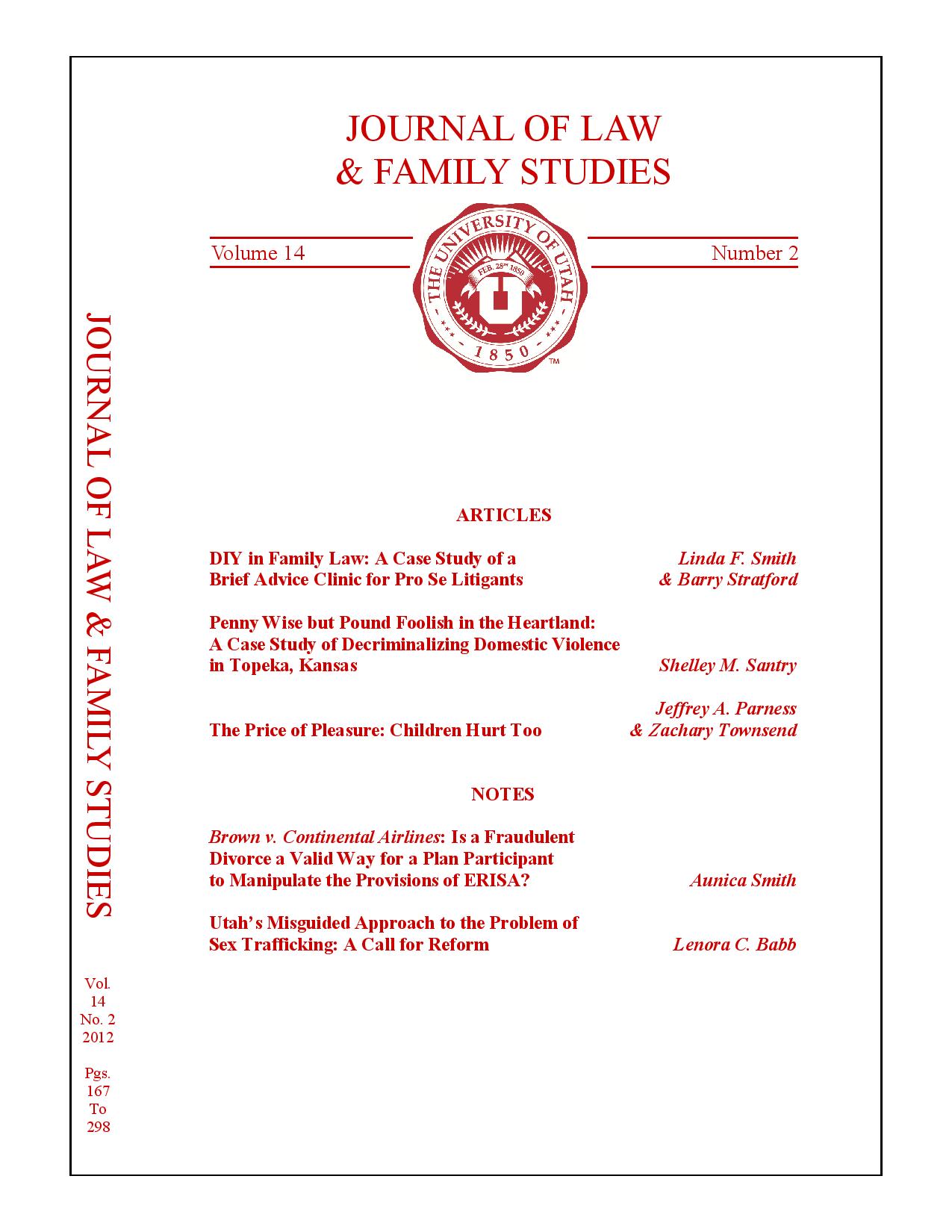THE PRICE OF PLEASURE: CHILDREN HURT TOO
Abstract
Shari Motro, in her articles entitled The Price of Pleasure and Preglimony, asks us to reconceptualize conception. She proposes, at least idyllically, substantial reforms to the laws on male responsibilities to females for harms caused by human conception via consensual sex. Her goal is to minimize the “fundamental gender imbalance.” A man who engages in sex leading to conception is currently not legally obligated to compensate his female partner for harms associated with pregnancy, including psychological injuries, lost wages, maternity clothes, or childbirth classes. The status quo resembles an unfair “one-size-fits7-all” approach, Motro says, and requires the woman to shoulder all the burdens of accidental pregnancy in the absence of a marital relationship. The current legal default regime treats “lovers as strangers” and pregnancy as a woman’s problem. Motro argues for a new paradigm that holds men responsible for the burdens of pregnancy of their unmarried lovers. For Motro, marriage is an inadequate cure to the current legal presumption disfavoring pregnant women. She opines that marriage does not effectively “regulate the vulnerabilities that come along with reproduction” and fails “as society’s main mechanism for safeguarding the interests of the accidentally pregnant . . . .”  Motro proposes “something that falls in between that of complete strangers and that of spouses, unless they agree otherwise.” Sexually active couples would be free to opt-out, because “casual lovers . . . should be permitted to set their own rules.” Couples desiring “a no-strings-attached encounter,” that is “those who expect to have no responsibilities vis-Ă -vis each other should pregnancy occur,” would be free from obligations. Motro supports a novel legal status for lovers who do not expressly opt-out, finding that theories like unjust enrichment or an equity-based approach sustain pregnancy-support claims. According to her, sex implies a promise—“an agreement to assume mutual obligations of support [where] communication can be inferred.” Motro supports the enforcement of such an unspoken pact in the event of breach, “when the promise is broken and pregnancy support is not forthcoming . . . .” Motro draws from tort and contract principles used by those involved in “controlled sadomasochism,” focusing on the prevalence of liability waivers. She suggests that contracts regarding sadomasochism can inform a new approach to the law of conception because such contracts similarly recognize “that intimacy involving inherently unequal risks demands explicit discussion regarding the allocation of potential consequences.” Motro uses sadomasochism to illustrate that contract law can (and does) apply to many sexual relationships. She suggests that risks of malfunctioning sadomasochism equipment can “mirror” other risks of sexual behavior, including pregnancy. Motro explains that individuals who engage in sadomasochism often sign agreements indicating that the involved parties will be free from liability in the event that devices fail or that there is a mistake or accident. Motro argues that the use of contract law can similarly apply in certain sexual encounter settings outside of sadomasochism, including where an unmarried man and an unmarried woman conceive a child when the two previously agree that the man will be wholly or partly liable for the costs of the woman’s pregnancy, and where an unmarried man and an unmarried woman conceive a child but the couple has not previously discussed who is liable for the costs of the woman’s pregnancy. Unfortunately, Motro does not explore the implications of her proposal beyond these scenarios. Would conception trigger pregnancy-support obligations when one sexual partner is married and one sexual partner is unmarried? Does it matter if the unmarried partner is male or female? And what if both partners are married to others? If a marriage or dissolution of marriage occurs after conception but prior to birth how should pregnancy-support obligations then operate? Motro’s proposal is limited not only by her identification of the couples involved, but also by her limited focus on the ensuing harms. Motro focuses on pregnancies leading to abortion, miscarriage, or birth. She does not discuss whether lovers should be liable for other harms stemming from sex, including sexually transmitted diseases. Should the law comparably treat “lovers as strangers” in pregnancy and infectious disease settings? Most curious for us is Motro’s utter failure to discuss the children in the birth setting. Her (utopian) proposals attempt to separate horizontal relationships (between sexual partners) from vertical relationships (between children and parents). We suggest a different approach when there are children, accepting Motro’s invitation for conversation.Â
Published
2012-10-26
How to Cite
.
THE PRICE OF PLEASURE: CHILDREN HURT TOO.
Journal of Law and Family Studies, [S.l.], v. 14, n. 2, oct. 2012.
Available at: <https://epubs.utah.edu/index.php/jlfs/article/view/782>. Date accessed: 18 dec. 2025.
Issue
Section
Articles
Copyright Utah Law Review All Rights Reserved.
Authors who publish with this journal agree to the following terms:
- Authors retain copyright and grant the journal right of first publication with the work simultaneously licensed under a Creative Commons Attribution License that allows others to share the work with an acknowledgement of the work's authorship and initial publication in this journal.
- Authors are able to enter into separate, additional contractual arrangements for the non-exclusive distribution of the journal's published version of the work (e.g., post it to an institutional repository or publish it in a book), with an acknowledgement of its initial publication in this journal.
- Authors are permitted and encouraged to post their work online (e.g., in institutional repositories or on their website) prior to and during the submission process, as it can lead to productive exchanges, as well as earlier and greater citation of published work (See The Effect of Open Access).


